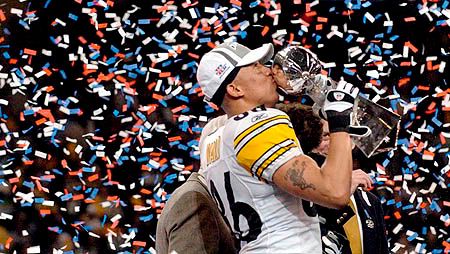There’s a fly on the wall
It wasn't until the Spring of 1985 that AC/DC regrouped to work on their new album at Mountain Studios near Montreux, in Switzerland. Happy with the raw sound they'd achieved with 'Flick Of The Switch', Malcolm and Angus decided again to produce by themselves.
'Fly On The Wall' was released on June 28. Despite the general critical thumbs-down, the album did reach No. 7 in the UK charts. The first single taken from the album, 'Danger', only made No. 48.
In addition to the album, there was a 28-minute long-form video titled 'Fly On The Wall', which featured five songs from the album. The concept was based around the band playing a gig in a small New York club full of shady characters.
The Fly On The Wall world tour began with another visit to the States. In January 1986, AC/DC played 6 shows in the UK and 18 more in Europe until mid-February.
On February 16, the band returned to London to start work on a video for their next single. During January, 'Shake Your Foundations' had become their most successful single since 'For Those About To Rock' when it reached No. 24 in the UK charts.
Who Made Who
During the 1985 American tour, AC/DC were approached by horror-writer Stephen King, a huge AC/DC fan, who'd asked whether he could use some old material for the soundtrack of his forthcoming movie 'Maximum Overdrive'. He also suggested the band record some new tracks exclusively for the film.
Recording took place at Compass Point Studios in Nassau when the US Tour had been completed. For the first time since 'If You Want Blood You've Got It', the new material was produced by Harry Vanda and George Young. In just two weeks they recorded three new songs: 'Who Made Who', 'D.T.' and 'Chase The Ace'. The video was filmed at the Brixton Academy in South London at the end of February.
On May 3, 'Who Made Who' was issued, becoming the band's biggest hit in years as it soared to No. 16 in the UK charts. A month later, the album reached No. 11 in Britain. In America, the album only reached No. 33.
On the back of the film's appearance in the US, AC/DC again took the road in July. Originally planned to finish in September, the demand for extra dates prolonged the US tour until November.
At the end of the tour, the band took a two-month break before beginning the recording sessions for their next album.
Someone Blew Up My Video
After an extensive search for the right location, the studio chosen for recording the next album was Miraval in the South of France. Recording officially began in August. Harry Vanda and George Young came back to act as producers on a full album for the first time since 1978. No less than 19 songs were recorded for the new album, but when the tapes were shipped across to New York to be mixed during the autumn, only the strongest ten survived.
The first single from the album, entitled 'Heatseeker', was released on January 4, 1988. It quickly rose to No. 12 in the UK charts. The album itself, 'Blow Up Your Video', was released at the end of January and reached No. 2 in the UK charts, the best position since 'Back In Black'. Meanwhile, in the US it reached No. 12.
After three days of rehearsals at the Entertainment Center in Perth, Australia, the tour finally began on February 1. It was the first show AC/DC had done anywhere in over a year and the first show in Australia since 1981. And to make the occasion even more special, Isa and Chick Scott, Bon's parents, were present in the audience. The show was dominated by Bon Scott songs because in Australia, Bon Scott IS AC/DC.
After two nights in Perth, four at the National Tennis Centre in Melbourne, three at the Entertainment Centre in Sydney, one at the Globe Derby in Adelaide and two at the Entertainment Centre in Brisbane, AC/DC had played to over 130,000 fans in three weeks.
After their successful return to Australia, the band headed to the UK. But they only played in two cities in the British Isles, Birmingham and London. After the run at Wembley Arena in London, the band headed out to Europe, before coming back to the UK to finish off this leg of the tour with a final date on April 13 at Wembley Arena.
But Malcolm Young would not be joining the band for the forthcoming US tour. Malcolm felt in desperate need of a rest from touring, principally to kick a drinking habit, which escalated during long tours. The official reason at the time of his departure was 'exhaustion'.
AC/DC called up another member of the Young family, nephew Stevie Young, and continued as if nothing had happened. Not only did Stevie know all of the AC/DC songs by heart, but he was Malcolm's double physically as well. Stevie's first show with the band was at the Cumberland Civic Center in Portland, Maine, on May 3.
The US tour proved to be an enormous success for AC/DC. The band sold out more or less everywhere they played. Within a matter of weeks 'Blow Up Your Video' had become AC/DC's biggest selling album since 'For Those About To Rock'. The tour ended at the end of the year.
Cutting Edge
Meanwhile back in Sydney, Malcolm was slowly recovering from his problems. In the first few months of 1989, he and Angus spent some time in London (at Malcolm's house) and in Holland (at Angus' house) working on basic riffs and melody lines for the next album.
When work began on the material for the next allbum, rumours spread that Brian Johnson had left the band. Brian hadn't in fact left, he was simply tied up in the States finalising his divorce and straightening out various legal problems. This was the reason why he was unable to get involved in the writing of the lyrics of the new songs. So Malcolm and Angus wrote the words for the first time without the band's singer.
But there was a line-up change on the horizon. Whilst Malcolm and Angus were busy working on material, Simon was approached by Ronnie James Dio to play on the next Dio album 'Lock Up The Wolves'. This was meant to be merely a session situation for Simon, to fill in time before AC/DC went back into the studio. But a few months later it was announced that Simon had been inducted as a full member of Dio's band.
Now without a drummer, AC/DC started rehearsals for the new album in a barn close to Brighton. In November 1989, they brought in Chris Slade on a purely temporary basis, at the suggestion of their management. But as work on the album progressed Chris was asked to join.
After rehearsals in Brighton, the band headed for Windmill Road Studios in Ireland to start work on the album proper. This time the band elected to work with Canadian producer Bruce Fairbairn. The album was completed within six weeks at Little Mountain Studios in Vancouver, Canada.
First release from the album was the single 'Thunderstruck', which reached No. 13 in the UK charts. The album, entitled 'The Razors Edge', was released through the band's new label Atco in September. The album proved to be a huge seller, reaching No. 4 in the UK charts and getting up to No. 2 in the US. 'The Razors Edge' took AC/DC's global album sales past 60 million copies. In addition, they also breached the Top 40 singles chart in Britain with 'Moneytalks' and 'Are You Ready".
Two long-form video collections were also released during this period, namely 'Who Made Who', featuring footage covering the years between 1980-1986, and 'Clipped', which included all of the promotional videos from 'Blow Up Your Video' and 'The Razors Edge'.
With a whole new stage-show, The Razors Edge world tour began in America. By March 20 AC/DC was starting their European tour in Helsinki. The British leg of the tour began at Wembley Arena on April 15. After Europe, AC/DC returned to the States in May for the third leg of the world tour.
In August, the band was back to Europe for Donington and a series of 20 Monsters Of Rock festivals across the continent in 18 cities. This included one free show at the Tushino Airfield in Moscow on September 29 that attracted an estimated 500,000 fans.
The Moscow concert was presented as a "celebration of democracy and freedom" staged as a gift to the Russian youth for their resistance against the recent failed military coup. The show was televised in Russia, filmed for a documentary by music-video director Wayne Isham and recorded for a projected live album. The Russian concert was particularly significant in light of the fact that most Western rock music was outlawed in the USSR until the rise of glasnost. Although AC/DC had long been popular among Soviet youth, the band's recordings could only be obtained on the black market.
----
Wednesday, October 3, 2007
The AC/DC Story Continued
Subscribe to:
Post Comments (Atom)

 Stumble It!
Stumble It!













No comments:
Post a Comment